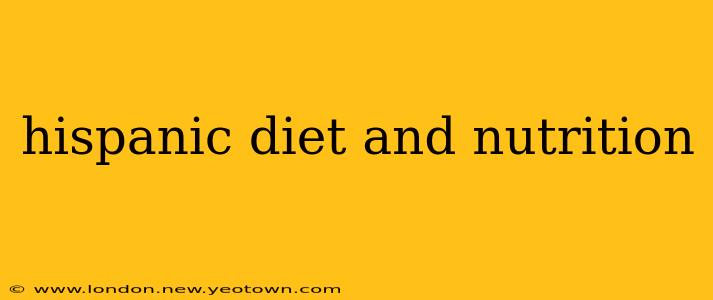The term "Hispanic diet" is a broad brushstroke painting a diverse culinary landscape. From the sun-drenched shores of Mexico to the vibrant streets of Puerto Rico, and across the vast expanse of South and Central America, the food traditions within Hispanic cultures are rich, varied, and deeply rooted in history and regional ingredients. While there's no single "Hispanic diet," certain common threads weave through these culinary traditions, impacting the nutritional profile and overall health outcomes of those who embrace them.
This isn't just about tacos and rice, though those certainly play a role! It's about understanding the complex interplay of ingredients, cooking methods, and cultural practices that shape the nutritional landscape of Hispanic communities worldwide. Let's delve deeper into this fascinating world.
What are the main components of a traditional Hispanic diet?
The core of many Hispanic diets revolves around fresh, seasonal produce, legumes, grains, and lean protein sources. Think vibrant fruits like mangoes and papayas, hearty vegetables such as corn, beans, and squash, and grains like rice and corn tortillas. Lean proteins, including fish, chicken, and various cuts of beef, are also incorporated, often prepared using methods that minimize added fats.
However, the specifics vary drastically depending on geography and cultural background. A traditional Colombian diet might differ significantly from a Cuban one, reflecting local agricultural practices and historical influences.
What are some common healthy aspects of the Hispanic diet?
Many traditional Hispanic dishes showcase a surprisingly healthy nutritional profile. The high consumption of fruits and vegetables provides ample vitamins, minerals, and antioxidants. Legumes like beans and lentils are excellent sources of fiber and protein, contributing to satiety and digestive health. Whole grains, while often refined in modern interpretations, traditionally contribute complex carbohydrates and fiber.
Furthermore, many Hispanic cooking methods, such as grilling, roasting, and stewing, require minimal added fats, contributing to a healthier dietary profile. The emphasis on fresh, whole foods also contributes to a diet that's naturally lower in processed ingredients and added sugars, often found in abundance in many Western diets.
What are some potential health risks associated with some Hispanic dietary patterns?
While generally nutritious, certain aspects of some Hispanic dietary patterns can pose potential health risks if not carefully managed. For example, the frequent consumption of high-fat meats, fried foods, and sugary drinks can contribute to obesity, type 2 diabetes, and cardiovascular disease. Also, the sodium content in some traditional preparations can be high, potentially raising blood pressure concerns. It’s crucial to remember that moderation and balance are key.
Are there specific Hispanic diets that are considered healthier than others?
It's inaccurate to label any specific Hispanic diet as inherently "healthier" than another. The nutritional value of any dietary pattern hinges on the specific food choices, portion sizes, and cooking methods employed. A diet rich in whole, unprocessed foods, prepared with healthy cooking methods, will always be more beneficial than one laden with processed foods, excessive fats, and sugars—regardless of its cultural origin.
How can I incorporate the healthy aspects of the Hispanic diet into my own eating habits?
The beauty of Hispanic cuisine lies in its adaptability. You can easily incorporate its healthy elements into your diet by focusing on:
- Increasing your fruit and vegetable intake: Explore a wider variety of fruits and vegetables, such as mangoes, plantains, avocados, and various types of peppers.
- Prioritizing legumes: Include beans and lentils in soups, salads, and as side dishes.
- Choosing whole grains: Opt for whole-wheat tortillas, brown rice, and quinoa.
- Selecting lean protein sources: Grill or bake chicken, fish, or lean cuts of beef.
- Using healthy cooking methods: Grill, roast, bake, or stew your food instead of frying.
- Limiting processed foods, added sugars, and excessive sodium: Be mindful of portion sizes and make conscious choices.
The Hispanic diet is a treasure trove of culinary traditions and nutritional possibilities. By understanding its nuances and incorporating its healthy aspects thoughtfully, you can create a balanced and flavorful eating plan that benefits both your taste buds and your overall well-being. Remember to consult with a healthcare professional or registered dietitian for personalized advice tailored to your specific needs and health goals.

